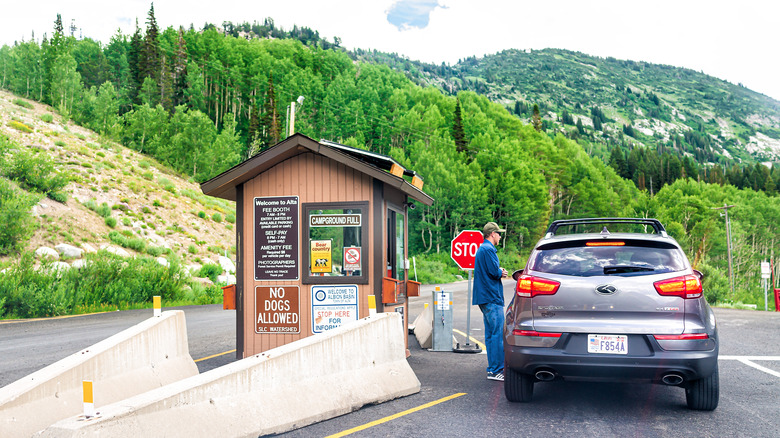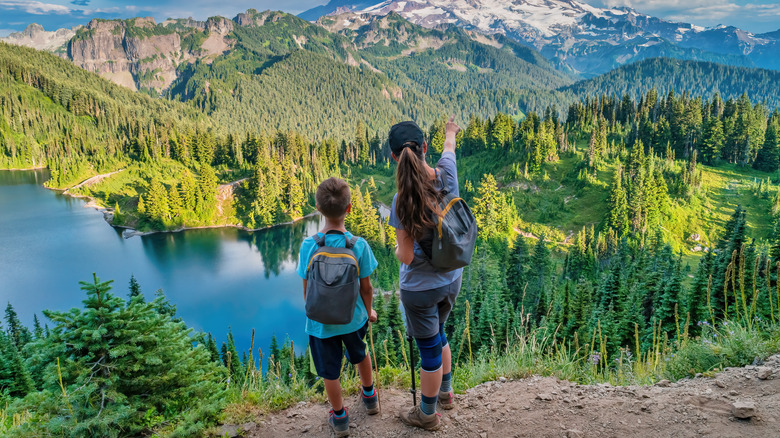What Is A US Parks Pass And Do You Really Need It?
The United States is home to some of the most breathtaking natural landscapes in the world, preserved within a vast network of national parks and federal recreational lands. From beautiful fall camping spots, to activities like ranger talks (which you might not have known about!), or even hiking trails for your dog, every park has something unique to offer — which is exactly why you should add some of America's national parks to your bucket list. While many of these parks and federal recreation sites are free, some do charge an entrance and day-use fee in order to support conservation efforts. While the cost of visiting one park isn't prohibitive, the fees can add up. Thankfully, the National Park Service offers a U.S. Parks Pass, which could help you reduce some of those costs.
But, what exactly is the U.S. Parks Pass? And, is it something you really need for your adventures? Let's find out.
What is the U.S. Parks Pass?
The pass, officially known as the "America the Beautiful — The National Parks and Federal Recreational Lands Pass" is an annual pass that grants access to over 2,000 federal recreation sites. For $80, you have unlimited entry to most of America's national parks, national wildlife refuges, and national forests, while knowing that your money is going to support the sites themselves! (Pro-tip: Buy directly from the National Park Service to avoid added commission costs.)
The pass's usage works differently based on the entrance regulations of the park you are visiting. For example, some national parks charge entry per vehicle. In that case, the pass covers everyone in the vehicle (so long as the pass owner is also present). This is also applicable to RVs, motorhomes, and rentals. If a park charges entry per person, the pass can be shared amongst a group of up to four adults, inclusive of the pass owner. What about kids? Well, kids under 16 can enter for free anyway!
A U.S. Parks Pass can be used for one year from the month you purchase it. For example, if you buy a pass on June 24th, 2024, the pass will be valid until the end of June in 2025, meaning you're not limited to the calendar year to maximize your savings. But, how much money can you really save? Let's do the math.
Are the savings really worth it?
The pass' use depends on a few factors. For one, how many federal sites are you planning on visiting within the next 12 months? Remember the pass is only valid for federal sites, not state parks—it can be easy to get this confused when you're doing a lot of planning. Once you know which parks and reserves you're planning to visit, search up whether they charge an entry fee on the National Park Service's website. The website includes the fees and entry information for all federal sites, not just parks, so it is a great one-stop-shop for your research. International tourists, who are also eligible to buy the U.S. Parks Pass and have it shipped to their home, will find this an incredibly convenient tool to do their planning.
Calculate the total estimated cost of your visits for the year. Remember that some parks charge entry by day, while others charge by visit. Also, don't forget to check whether the entry fees are per head or per vehicle. In some cases, a multi-day, whole family visit to a single park would be enough to warrant purchasing the park pass.
Once you've summed up the costs, check if they exceed $80. If they do, the U.S. Parks Pass is probably a smart purchase.
Other factors to remember
If you're visiting 4 or 5 different sites within a period of 12 months, the U.S. Parks Pass seems like a no-brainer. But, not everyone is in these clear-cut scenarios. Perhaps most of your paid visits this year are to only one or two parks. If that's the case, you may want to see if that specific park has its own annual pass. For example, maybe you only have the time to visit Mount Rainier National Park a handful of times this year. Well, Mount Rainier offers its own annual pass at $55 dollars, which would make that a better investment for you.
On top of that, some parks have limited capacity and timed-entry. Though you may plan on visiting all these parks, make sure you confirm your visit before making your parks pass worth it. You'd hate to spend your money and then not be able to put your pass to use. In the opposite vein, maybe the site you're planning to visit is offering free admission on the days you plan to go. Some sites offer these special events over the course of a year, so it's definitely worth checking out.
One more factor to keep in mind is that the pass only includes entrance fees. Activities like tours that cost extra should not be accounted for in your calculations, as all visitors will be required to pay for them. The same goes for if you plan on camping overnight, which usually requires a separate reservation fee.
Alternative passes that may be worth it
Beyond the U.S. Parks Pass, the National Parks Service offers other variants of the pass. The Senior Pass is available to U.S. citizens or permanent residents ages 62 or older. It is offered as an annual pass for $20, or as a lifetime pass for $80, meaning incredible savings. U.S. citizens or permanent residents with disabilities, as well as current U.S. military members and their dependents, can get an Access Pass or Military Pass, respectively, which allows them to access federal parks and sites free of charge.
For outdoor enthusiasts who want to immerse themselves in the nation's wilderness, there is a Volunteer Pass. Volunteers who provide 250 hours of service to federal agencies can also gain free entry to national parks and reserves.
Last, something that parents and caretakers with a child in 4th grade may be interested in is the 4th Grade Pass. As part of the Every Kid Outdoors Program, students who are in the fourth grade can get a free annual pass valid for the duration of the school year and the summer following. Plus, according to users on Reddit, these benefits extend to the whole family!




